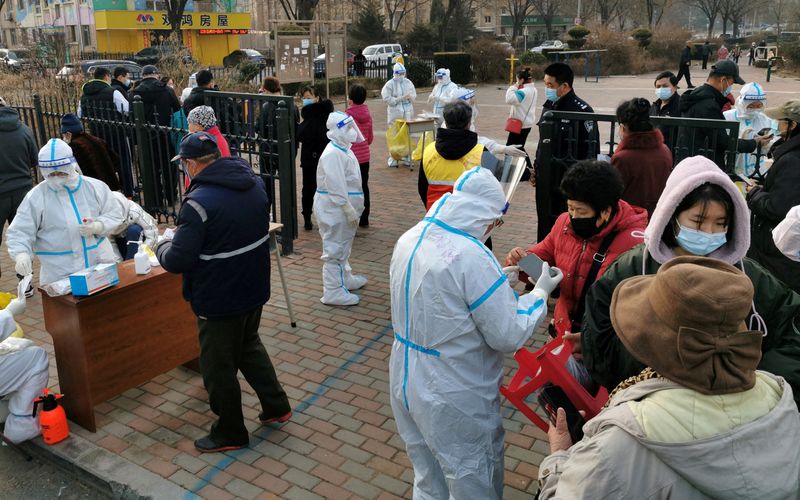By Ryan Woo, Roxanne Liu and David Stanway
BEIJING (Reuters) - China's public health governance is expected to come under acute pressure in coming weeks as the biggest wave of COVID-19 cases since the 2020 Wuhan outbreak stretches medical resources, tests the country's ability to contain infections and strains the economy.
In the past 10 weeks, China has reported more new local symptomatic cases - more than 14,000 - than in all of 2021 amid the rapid spread of the Omicron variant, fuelling fears of hard lockdowns of cities and economic instability.
Some parts of China are already feeling the crunch as they scramble to test local populations and quarantine the infected under China's strict COVID-19 playbook, despite relatively low caseloads by global standards.
In the northeastern province of Jilin, the hardest-hit region in the current outbreak, affected cities are racing to prepare temporary hospitals. A local official said on Tuesday the province's epidemic prevention supplies will run dry in two to three days.
"The next two weeks are key to determining whether existing policies can really be effective in curbing infection growth or even reaching completely zero cases in one city as we saw last year," said Chen Zhengmin, professor of epidemiology at the University of Oxford.
China has stood firmly by its "dynamic" zero-COVID policy - rigorously identifying infections and blocking them as they emerge but not insisting on zero infections - for both public health and political reasons.
Although China has a vaccination rate of nearly 90%, Chinese experts said not enough elderly people have received boosters, risking deaths and severe cases. It is also unclear how well Chinese vaccines reduce the risk of developing the disease caused by the Omicron variant.
China's leadership has staked much on its COVID-19 battle, and would be loath to alter course in a sensitive year when President Xi Jinping is set to secure a third term.
"Preventing and controlling epidemics has become more difficult," National Health Commission spokesperson Mi Feng said on Tuesday. But he stressed "it has been proved in practice" that China's current virus measures are still effective against Omicron.
The country is also struggling to balance pandemic measures with an economic recovery. Citi analysts estimate the latest wave will shave 0.5-0.8 percentage point from first-quarter GDP growth.
China should consider less disruptive or resource-consuming measures, including allowing asymptomatic infections to quarantine at home, though such a move is unlikely to happen soon, some experts say.
"The old way has been very effective, regardless of the cost, and [epidemic prevention] is the biggest political task," Chen said. "Also, if such a change is made, the general public might misinterpret that as giving up."
Some experts already say China's COVID approach is no longer sustainable.
Kyoto University professor Hiroshi Nishiura, who led an early Wuhan study in 2020, said he was "not very optimistic," even if strict lockdowns slow the spread.
"Multiple introductions (of Omicron) in mainland China would be unavoidable," Nishiura said.
(GRAPHIC: COVID-19 cases in mainland China (2021-2022) - https://graphics.reuters.com/HEALTH-CORONAVIRUS/CHINA/znvnenaadpl/chart.png)
HIGH STAKES
China is trying to strike a balance between targeted curbs to stop the virus's spread and ensuring disruptions do not worsen an already uncertain economic outlook.
Shanghai and Shenzhen have adopted tougher restrictions rare for those two cities - one closing all primary, middle and high schools and the other suspending non-essential businesses - but stopped short of a harsh lockdown such as the one in Wuhan in 2020.
China's COVID-19 policy has not completely broken down, but daily increases of over 1,000 cases are a warning sign, said University of Hong Kong professor Jin Dong-Yan.
To bolster China's testing ability, authorities last week approved the use of self-administered antigen testing kits as a supplement to polymerase chain reaction tests.
China said late on Tuesday that patients with mild symptoms will be quarantined at centralised facilities, revising an earlier requirement of moving them to hospitals, in response to concerns about medical resources.
"The worst-case scenario for them is that Omicron will overload the Chinese health-care system, and the entire country is inundated with COVID cases," said Huang Yanzhong, senior fellow for global health at the Council on Foreign Relations.
In mainland China, the official death toll has been largely static since 2020, with only two fatalities reported in 2021 and none this year.
The elderly in China are vulnerable to Omicron variants, so "a substantial number of cases and deaths would be expected," said Kyoto University's Nishiura.
ECONOMIC TOLL
There are signs some cities are taking a harder line.
Shenzhen, home to about 17.6 million people, said on Monday only one member of a household could venture out every two to three days to stock up on necessities.
"I think there is no way to stop Omicron now," said Peter, 49, a Shenzhen resident and owner of a VR startup. "The only way is to maintain normalcy and welcome the virus. You see abroad, the coronavirus is like a cold. Many people have recovered and travelled everywhere. Why are we trapped here?"
In Shanghai, 106 international inbound flights scheduled from March 21 and May 1 will be diverted to other Chinese cities.
Businesses from automaker BYD to KFC operator Yum China say their operations have already been hit, with more disruptions expected as cases mount.
In the locked-down city of Changchun, the impact of curbs has been hard.

Guo, owner of a pedicure and beauty salon, said she was worried about her loans and her workers' salaries.
"I'm feeling very overwhelmed right now," Guo said. "Only those who are in an epidemic zone would understand this feeling."